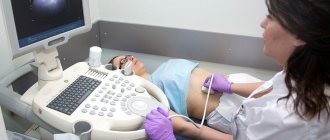Ovulation days are the time when the probability of fertilization of an egg that has matured and released into the abdominal cavity is highest. They are determined for successful pregnancy planning. The process of rupture of the follicle and the release of the egg is accompanied by a change in the concentration of hormones (hormonal levels) in the female body. This is evidenced by some subjective signs. You can independently determine the onset of a fertile period by carefully listening to your feelings or using one of the methods available for home use. These methods are not very accurate and can produce an error of several days. But in most cases, they are quite enough to significantly increase the chances of conceiving a baby or, on the contrary, prevent the onset of an unwanted pregnancy.
Ovulation - features of the process
In simple terms, ovulation represents the possibility of fertilization. At this time, the woman’s cell enters the reproductive tract. In the event of a successful meeting with a sperm, conception will occur; if it is absent, the cell will die. The processes occur cyclically, repeating from month to month. It falls almost in the middle of the girl’s cycle.
To calculate ovulation, it is necessary to understand the processes occurring in the female body during each period of the menstrual cycle
Menstrual cycle
The cycle is the time interval between the first dates of menstruation. It is divided into three main periods:
- Follicular. From the beginning of bleeding, the vesicles in the ovary mature. Each cycle, the ovaries work in turn, but peculiar malfunctions often occur when the action occurs in one ovary for two periods in a row or there is no maturation of the follicle at all. Over time, one of the bubbles outstrips the others in size. It is in it that the egg is born. It begins to grow faster and faster, to a limit of 20-24 mm. With such a follicle size, the cell is considered mature. By this time, the remaining bubbles disappear due to atresia (reverse development).
- Ovulation. Having reached the peak of development, the cell breaks the wall of the follicle to come out. She begins to move towards the uterus. If she meets and comes into contact with a sperm, fertilization is very likely. In the absence of male cells, the female one will collapse a day after release.
- Luteal. At the site of the break formed by the cell, the corpus luteum grows. It promotes wound healing and produces a special hormone - progesterone. Its concentration in the body is necessary to accompany the processes of fertilization, implantation and the development of pregnancy in general. If conception is successful, it will be produced throughout the pregnancy to ensure the proper development of the embryo. If there is no effect, by the end of the cycle the corpus luteum stops functioning, after which menstruation occurs.
A girl's menstrual cycle consists of three phases - follicular, ovulation and luteal.
Duration of stages
The duration of each stage differs in women, based on the characteristics of the body and the length of the cycle:
- Follicular phase: 11-17 days. It is considered normal if the cell matures in 14 days. The rate of its formation depends on the hormone estrogen and its concentration in the body. Since the natural balance of hormones in girls can differ greatly in ratios, the length of the phase will also be different. At the same time, due to stress or taking medications, the proportions of hormones change, which is why a cell can mature faster or slower in one month than in another. There are situations of late ovulation, when the cell appears once every 1-1.5 months.
- Ovulation: 1-2 days. The length of the phase depends on the viability of the cell. On average, it lives up to a day, but there are cases of a shorter life - 12 hours or a long life - up to 3 days. But such situations are very rare. It is precisely because of such a short time of cell functioning that the process of conception can be difficult to plan and implement. It is necessary to be able to correctly determine this day.
- Luteal: 14 days. Experts have found that it takes just that long to heal a wound on the ovary and bring the body “back to normal.” Very rarely, the phase can last 12-13 days.
The duration of each stage is individual; you should calculate your cycle and the length of each phase to calculate ovulation
Characteristic signs of ovulation - discharge
Specific signs of ovulation will help to clearly determine the date of cell release in order to “guess” the moment for conception. Female discharge is considered the most striking. They have a different structure and appearance at each stage. By observing the external manifestations of mucus, you can easily find out the day before and when the cell came out.
Cervical mucus changes structure depending on the balance of hormones. Based on which hormone predominates in the body, it can thin out or thicken. Typically, discharge is characterized by the following symptoms at each stage of the cycle:
- During the growth of the follicle, estrogen acts, which liquefies the mucus. The secretion becomes very thick and acts as a mucus plug, blocking the access of microbes and sperm to the uterus, since fertilization is impossible at this period of time and their presence is undesirable. Due to this thickness, the discharge does not come out and cannot be detected on the underwear.
- As the cell grows, the level of estrogen begins to decrease, due to which the mucus gradually thins out, but practically no external discharge is observed.
- After the cell appears in the genital tract, due to the rupture of the follicle, a surge of luteinizing hormone occurs. The proportions of hormones formed at the moment of ovulation change the structure of the mucus. It becomes viscous, transparent and is produced many times more. This consistency is optimal for the advancement of sperm and promotes cell vital activity. Due to similar external characteristics, mucus is called “egg white”. It may contain brown blood, which is considered normal, since the follicle has ruptured and a droplet could have entered the peritoneum. Since there is no discharge outside until the moment of ovulation, the girl will not be able to miss the appearance of such an abundance of mucus on her underwear. The mucus in the egg white state will be observed for a couple of days. For some, it is detected for two more days immediately after the cell is released, and for some (usually women over 35 years old), the entire period can take one day or day.
- After the growth of the corpus luteum and an increase in progesterone levels, the mucus begins to thicken. She prepares to clog the fallopian tubes when the fetus is successfully implanted in order to protect the embryo from the penetration of external bacteria. Therefore, the discharge practically stops.
- If conception does not happen, on the eve of the next cycle of bleeding, the mucus thins out a little, becoming somewhat watery.
As you can see, any girl can observe her discharge and, if profuse and viscous manifestations are detected, begin conceiving on this day and the next two, since this is a sure sign of ovulation.
What it is
Ovulation translated from Latin - ovum - means egg. In medicine, this term refers to the stage of the menstrual cycle. During this period, a mature follicle ruptures in the woman’s body, which is accompanied by the release of the egg from the ovary and its movement to the uterus.
Symptoms of ovulation become apparent as a result of the fact that the entire process is regulated by the production of hormones - luteinizing and follicle-stimulating. They are the ones who influence a woman’s entire menstrual cycle. The follicular phase of the menstrual cycle continues until ovulation. At this time, the follicle grows under the influence of follicle-stimulating hormone or FSH, as it is also called. When the follicle reaches the desired size and begins to function, estrogens begin to act, resulting in the maturation of the egg.
At the moment of maturation, the follicle ruptures and a fully mature egg is released. This process is called ovulation.
Next, the female cell moves to the uterine cavity along the fallopian tube. During this period, either conception occurs or it does not, and then the unfertilized egg dies within about a day.
Ovulation
Pain during ovulation - causes
As we have already discussed, when leaving the follicle, the cell breaks the ovarian wall. This is a common wound, and therefore can cause discomfort and unpleasant pain. Usually, a woman does not notice the sensations during ovulation unless she specifically listens to her body. This is due to the insignificance and low intensity of such pain.
You should not worry if you experience minor and short-term pain during ovulation, this is a natural physiological process
Pain in the sides
If you count approximately the moment of ovulation and observe yourself, you can pay attention to some tingling, possibly aching or nagging pain. It lasts differently - from a single sensation to several hours or even up to 2 days. There are girls who feel very severe pain, tingling, and often a rebound in the lower back. At the same time, from month to month the sensations are felt from different sides. This depends on the ovary that produced the cell this month.
Stomach ache
Sometimes pain is felt in the peritoneum (lower part), which causes some anxiety in women. This may be caused by a drop of blood from a ruptured follicle entering the abdominal cavity or retrouterine space. There is no need to worry, it will come out naturally. If after a couple of days there are no changes, but there is an increase in temperature and general signs of malaise, it is better to immediately visit a doctor to prevent adverse consequences.
For prolonged pain that does not stop after the completion of the ovulation process, you should consult a doctor.
Prolonged pain
If pain is felt just a few days after the cell is born, it is worth clarifying a few points:
- If you have sexual intercourse at the time of ovulation, fertilization is likely to have occurred. When the embryo is implanted into the uterus, tissue stretching occurs, which is accompanied by pain. And this happens 7 days after conception.
- In the presence of nausea, elevated temperature, an inflammatory process, tumor formation, disturbance in the location of the appendages and other abnormalities are possible. You should visit a specialist.
- If the pain is severe and occurs during other periods of the cycle, inflammation of the appendages, rupture of the ovarian wall, or other unpleasant diseases and problems are possible. It is unacceptable to postpone a visit to the doctor.
Causes of pain in the chest and nipples
The main causes of chest pain are:
Hormonal changes
Hormonal imbalances are considered a fairly common cause of breast swelling and tenderness. An increase or decrease in the level of steroid hormones negatively affects the condition of the mammary glands.
Manifestations may vary:
If you have at least one of the listed signs, you should contact a gynecologist or mammologist. Most often, a course of medications that regulate hormonal levels is prescribed.
Other symptoms of ovulation
Minor pain and peculiar discharge are the most striking and common symptoms of ovulation. But there are some others that will also help to correctly determine the moment.
Breast
Under the influence of progesterone, the mammary glands begin to change. This symptom is more common after the follicle ruptures, but the girl will still have several hours or a day before the completion of the ovulation stage.
Swelling of the mammary glands and slight pain in the breasts during ovulation should not cause much concern for a woman
Since all processes in the body are interconnected and it reacts to any changes, the moment a ready-made cell appears, it begins preparation for the process of childbirth and subsequent breastfeeding. Therefore, the mammary glands swell somewhat. This may feel uncomfortable or even painful, especially if it rubs against clothing. But for some girls this process occurs without consequences, and they fail to pay attention to it.
Attraction
The appearance of a ready-made cell in the genital tract also signals the body about its desire to reproduce offspring. Therefore, a woman’s libido and physical attraction increase. This happens mainly on a subconscious level, but it is very easy to catch the tendencies and wishes of your body.
The ovulation process is often accompanied by increased libido and physical attraction
Why do women have breast pain in the middle of their cycle?
Each woman's menstrual cycle is individual, but there is one common feature - regularity. Even the slightest failure makes a woman think about her health. If your chest hurts in the middle of your cycle, this may be a harbinger of ovulation - a normal physiological phenomenon. But in cases where breast tenderness causes discomfort and other unpleasant signs appear, you should not delay visiting a specialist.
Calendaring - calculations
Every girl should keep her own menstruation calendar. It should only note the first days of their onset. Such a calendar helps to control the normal course of processes and female function. It is known that any deviations in the calendar may indicate a disease, dysfunction of the reproductive system, etc. It is necessary to control the following points:
- Cycle length. Count the number of days between the first numbers. Normally, the figure is close to 28 days.
- Regularity. The duration of the cycles should be identical, with a minimum deviation of 1-2 days.
- Number of days of menstruation. Normally, the nature of the discharge, structure, abundance and duration should be the same in each period.
Monitoring your menstrual cycle is important for a timely response to changes in the body that can be caused by serious diseases
Ovulation
In the same calendar, a girl can calculate the expected ovulation when a decision is made to plan the birth of children. These will be approximate values that you need to focus on, combining them with observations of your sensations. The calculation is carried out according to the algorithm:
- Subtract 14 from the length of the cyclic process. As we remember, this value is characteristic of the luteal phase and is the same parameter for everyone.
- Count the resulting number from the first day of your period in the current period. Mark the date of the expected release of the cage on the calendar.
- Mark as favorable two days before this date and one after.
You can use our calculator to create a women's calendar for several months in advance
Irregular cycles
If the process is irregular, when a girl’s deviations between periods can be 5-6 days or more, you need to act differently. Preliminarily compare all your cycles over several months of observation, choose the smallest one. 14 is already subtracted from it. But for an irregular cycle, such indicators are very approximate. The girl should, starting from the calculated date, observe changes in the body and secretions. If the symptoms described above are detected, you can begin to have regular sexual intercourse.
With an irregular menstrual cycle, ovulation can be determined by characteristic symptoms
Additional options for determining ovulation
In addition to observations and calculations, a girl can use some methods to determine the day the cell appears with a high probability:
- Home tests that analyze urine.
- Microscopes and apparatus for saliva analysis.
- Maintaining a chart of rectal temperature measurements.
- Carrying out an ultrasound.
Ultrasonography
The last option is the most reliable and accurate. But it is worth contacting him if you cannot figure out the day of cell appearance on your own due to the irregularity of the processes occurring or in the absence of characteristic symptoms of ovulation.
In such a situation, the doctor begins an ultrasound examination approximately from the 5-7th day of the cycle or from the 9th day, with higher indicators of its length. He monitors the appearance of the follicle and the rate of its growth, for which he prescribes examinations every 1-2 days. When it reaches the desired size, the doctor informs about the date of release of the cell and prescribes the optimal days for sexual intercourse in order to conceive.
To accurately determine ovulation, it is better to contact a clinic for an ultrasound scan.
Tests
If the girl has no problems with regularity and symptoms, but only needs to confirm the appearance of the cell, it is worth using standard tests, which are easy to purchase at any pharmacy. The test has stripes impregnated with the reagent. It shows the level of concentration of luteinizing hormone, which splashes out in large quantities immediately before the rupture of the follicle. It is recommended to start testing 3 days before expected ovulation and compare test strips every day. If a brighter shade is detected, it can be stated that the day of ovulation has approached and days for conception can be set.
There are many different variations of tests to determine ovulation, but they are all based on the principle of determining the level of concentration of luteinizing hormone
In addition to the standard strip strip, there are other varieties of a similar product that work on a similar principle. The differences are only in the method of analysis or in deciphering the result:
- Cassette. They are considered more convenient, because the paper strip is placed in a special case.
- Jet. Used by directing a stream of urine onto the strip. There is no need to collect liquid, and therefore it can be used even in a public toilet, and not just at home.
- Electronic. They are used as strip strips, but have an advantage in assessing the answer. A girl doesn’t need to compare shades, which always raises a lot of questions. The answer will be displayed on the screen.
Microscopes
Devices such as microscopes are very convenient in comparison with strips, and are also reusable, which affects their cost. This option is suitable for a girl who has difficulties identifying the day and the process of fertilization.
For girls with irregular cycles, it is better to use a microscope-type device to accurately determine ovulation from saliva
They can be used anywhere, they are very compact and easily fit in a bag. It is necessary to apply a smear of saliva onto a glass slide and look at it through a microscope. The salts contained in saliva form a peculiar pattern that takes on the features of a fern leaf at the moment the follicle wall ruptures.
Basal temperature
Charting basal temperature is the most labor-intensive method. It is necessary to take rectal temperature measurements daily and mark the indicators on the graph. By observing the curve, you can note a decline before ovulation and an increase during cell release. This way, the girl will be able to find out in advance about the onset of a favorable moment, noticing characteristic jumps. The whole difficulty is that these “peaks” are in the range of 0.4-0.6 degrees, and therefore the accuracy of the measurement is very important.











